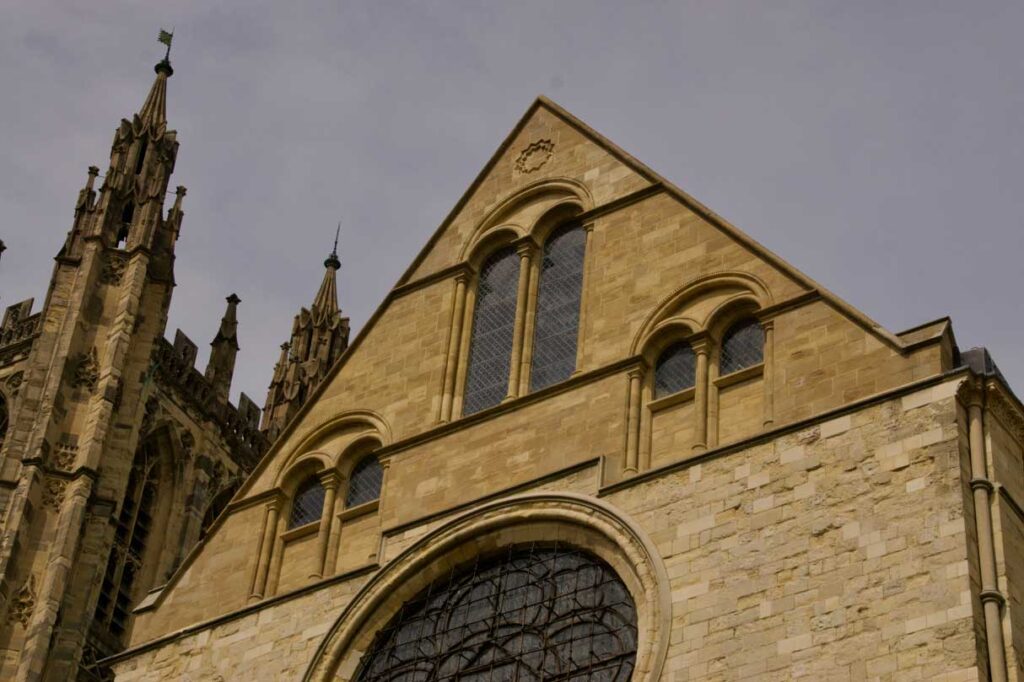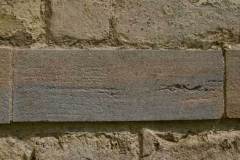- Basics
- Geology: coarse shelly and oolitic limestone
- Rock unit: Lincolnshire Limestone
- Age: Middle Jurassic
- Provenance: Clipsham, Rutland
- Where to see examples:
- SE transept gable (image on the right)
- SE side of Corona (first 2 images below)
- pinnacles above south nave aisle (3rd image below)

Description
In the 1920s the Cathedral authorities turned to a new stone for the restoration of the cathedral fabric. Clipsham Stone, a Jurassic oolitic limestone from Rutland was the chosen material. It has been a popular stone for restoration work throughout England since the nineteenth century and has been widely used as a building stone since Roman times.
Clipsham Stone is often recognised as the hardest of all the English Jurassic limestones and commonly contains a variety of shell fragments and small spheres of calcium carbonate called ooliths. The natural colour of the stone varies from light brown to pale orange to cream-coloured, although blocks can be blue-hearted. A blue-hearted stone is one where the core is blue-grey in colour in contrast to that of the exterior. When iron minerals are deposited in an oxygen-free environment, they have a typical blue-grey appearance. However, in the presence of oxygen, iron minerals in sediments are usually oxidised (rusted) to an orange-brown colour. Examples of blue-hearted stones can be seen on the south-facing buttresses of the Trinity Chapel.
During the 1920s and 1930s The Clipsham Quarry Company from Clipsham, near Oakham, supplied the cathedral with most of its building stone. They advertised their product as “A First-Class Weather Stone” and “Unsurpassed for Durability”. In 1933 William Caröe, the Architect of Canterbury Cathedral, had described the stone as “one of the best weathering oolitic stones upon the market”.
Clipsham Stone was a good quality building stone, but the quality of stone from the quarry was found to vary greatly. The “hard grey bed” was repeatedly requested for replacement stone at the cathedral, but all too often a stone of “soft quality” would be delivered; there was no compunction in returning it. “This stone is for a national possession“, the agent for the Dean and Chapter’s declared in 1925, “and the quality of the stone must be of the hardest which you know, and your high price is for this standard”. The quarries closed in 1939 when the quarry workers joined the armed services. Although the quarries re-opened a few years after the war the Dean and Chapter had by then sourced a new replacement stone.
The cathedrals of Peterborough, York Minster and Salisbury have all used Clipsham Stone for restoration work as well as the Palace of Westminster. At Canterbury, repairs to the Bell Harry Tower have been carried out in Clipsham Stone, as has the gable end of the south-east transept, where today the stone can be seen to have weathered to a distinctly orange colour.
At the time of writing (October 2017) the cathedral authorities are considering the replacement of decayed Clipsham Stone with a newly quarried Clipsham Stone (from a different, but nearby, working quarry). If agreed upon a visit to the quarry will take place next to help make a more informed decision.
Click on the images below to expand and read the captions.


